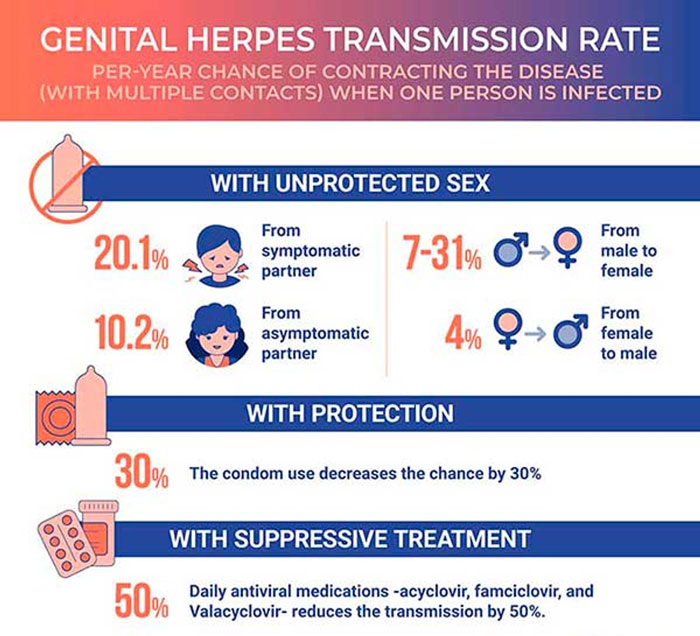HSV 2 transmission rate
The transmission rate of HSV-2 (Herpes Simplex Virus Type 2) can vary depending on various factors such as the presence of symptoms, use of protective measures like condoms, and whether antiviral medications are taken.
However, generally speaking, HSV-2 is highly contagious, especially during outbreaks when symptoms like genital sores or lesions are present. But up to 70% of new cases of herpes are transmitted from someone showing no apparent symptoms at the time they infect their partner.
HSV-2 is primarily transmitted through direct skin-to-skin contact with an infected person, particularly during sexual activity.
HSV 2 transmission statistics
What are the chances of HSV-2 transmission? The probability of transmission appears to vary across studies, with reports typically ranging between 3% and 10%.
In a small study, the rate at which infected men transmitted herpes to women was found to be 2.9 times per 100 unprotected sex acts.
Contrastingly, a different study observed that nearly 10% of female partners acquired herpes from male partners over a year.
In a substantial study published in the New England Journal of Medicine (NEJM), the risk of acquiring herpes from an infected partner was 3.6% over an 8-month period.
Likelihood of HSV2 transmission with no outbreak and not on antiviral medication
According to the Centers for Disease Control and Prevention (CDC), studies have shown that the risk of transmission of HSV-2 from an infected person to an uninfected partner who is not having symptoms is approximately 4% per year when the infected partner is not using any suppressive therapy. However, this risk can be lowered with the use of antiviral medications and condoms.
It's important to note that even when no symptoms are present, HSV-2 can still be transmitted through asymptomatic shedding of the virus. The chart below is a guideline about how often shedding happe
- HSV 2 genital: 15-30% of days evaluated
- HSV 1 genital: 3-5% of days evaluated
- HSV 2 oral: 1% of days evaluated
- HSV 1 oral: 1% of days evaluated
Therefore, practicing safe sex, using condoms consistently and correctly, and being aware of any symptoms or signs of infection are crucial in reducing the risk of transmission. Additionally, open communication with sexual partners about one's HSV-2 status is essential for informed decision-making and risk reduction.
2024 No.1 Herpes Dating Site

Worrry about herpes transmission? Meet nearby HSV-2 positive singles now!
Likelihood of HSV2 transmission with no outbreak and on antiviral medication
The likelihood of transmitting herpes simplex virus type 2 (HSV-2) when there are no visible outbreaks and the infected individual is taking antiviral medication is significantly reduced compared to when outbreaks are present and medication is not being taken.

Studies have shown that antiviral therapy can reduce the risk of HSV-2 transmission by around 50%. However, it's important to note that antiviral medication does not completely eliminate the risk of transmission. Even when there are no visible symptoms (asymptomatic shedding), the virus can still be present and potentially transmitted to sexual partners, albeit at a lower rate compared to when active lesions are present.

Several studies have shown that consistent and correct use of condoms can significantly reduce the risk of HSV-2 transmission. The reduction in risk varies, but estimates suggest that condoms can reduce the risk by approximately 30-50%. However, it's important to note that this reduction in risk is not as high as for some other sexually transmitted infections (STIs) because HSV-2 can be transmitted from areas not covered by condoms.
The risk of transmission also depends on various factors such as the frequency of sexual contact, the use of barrier methods like condoms, the overall health of the infected individual.

HSV2 risk factors
Various factors influence the likelihood of HSV-2 transmission. The probability of passing HSV-2 from an infected partner is contingent on several elements:
Gender: The gender of the individuals involved can impact the chances of transmission. Why are women at higher risk for herpes?
Type of Sex: The specific type of sexual activity, including oral sex, plays a role in determining the transmission risk.
Frequency of Sexual Acts: How often sexual acts occur contributes to the overall probability of HSV-2 transmission.
Presence of Active Herpes Lesions: The existence of active herpes lesions or sores significantly influences the likelihood of transmitting the virus.
Time Since Infection: The duration that has passed since the herpes-positive partner was initially infected is a factor in transmission risk.
Herpes-Suppressive Medications: Whether the infected partner is using medications designed to suppress herpes can impact the chances of transmission.
Condom Use: The consistent and correct use of condoms is a crucial factor in reducing the risk of HSV-2 transmission.
Understanding and considering these factors is essential for individuals seeking to manage and minimize the risk of HSV-2 transmission in intimate relationships.
2024 No.1 Herpes Dating Site

Worrry about herpes transmission? Meet nearby HSV-2 positive singles now!